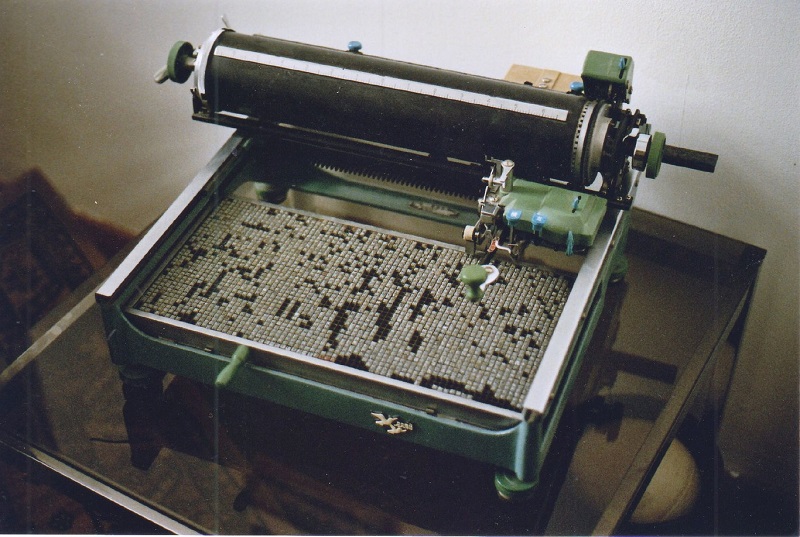I had never asked myself how to write Chinese with a normal keyboard. Unlike most alphabets in the world, Chinese writing is logographic. That is to say, it is based on the use of thousands of characters that represent syllables with a concrete meaning and that, when they come together, they form words of normal use.
A real madness. And even more so if we think about the type of keyboard that would be needed for it: a keyboard with thousands of keys that would make anyone mad. So it is not surprising that the precursor of the ‘self-correcting’ and ‘predictive keyboards’ were invented by the Chinese typist in the 1950s.

Typewriters
The typewriter is another of those inventions that have been invented over and over again. Specifically 52 times, according to the New Yorker. By the mid-nineteenth century there were typewriters pretty decent and qwerty keyboard, the fact standard, was created in 1874. But, of course, with the Latin alphabet it was easy: even including numbers and punctuation marks were very few characters.
In fact, the alphabetic languages are simple. The most extreme case (the Cambodian Khmer) uses 72 letters and, frankly, seems a cinch compared to the Chinese logographic system. To give you an idea, writing in more basic Chinese requires about two thousand characters. It takes about four thousand for a reasonable literacy and, if we consider all the characters that can be used, totaling more than eighty thousand.
Therefore, the first Chinese typewriters had to wait in the early twentieth century, when the mechanics was sufficiently developed to operate with a number of such high character.
The tray machine
The first machine that was developed was the one of tray. It was a machine that was about two thousand characters per tray, so typists had to use several trays to use the six thousand words often used in an administrative environment. Even more so if there were rare words.
As we see in the picture, the writer placed the mechanical arm over the type (which was upside down and upside down) and pushed to overprint the character on paper. To sort the different characters, it began using the same system used in dictionaries, radicals: 214 basic strokes with which you can compose all characters of Chinese writing.
The system allowed to work, but even in professional experts, was very slow. As I said, it was like looking up words in a dictionary to select them. It is estimated that, on average, could not write more than 20 or 30 syllables per minute. That is, between 10 and 20 words. A professional with an alphabetical machine can write 35 or 40 words without too much trouble (and the world record is over 150).
The failure of the construction machine and the beginning of the “predictive keyboards”
The process was so slow and complex that, throughout the first half of the twentieth century, engineers tried to find a way to simplify the process. In 1946, Lin Yutang patented a system that with about 72 keys was able to create more than 7000 characters. Its intention was to replace the traditional system of radicals by a system more similar to the traditional alphabets.
Lin’s invention could revolutionize Chinese writing, but was never manufactured. Some people consider that technical problems and failures of the first models slowed expansion plans new typewriter.
So are the Chinese typists had to settle in another way: by changing the order of the characters of the trays. In short, having seven or eight thousand characters of relatively usual use in the context of an administrative work, there are characters that were used more than others and characters that were used together.
You may also like to read another article on improtecinc: The future of photography? Possibly on a phone with sixteen cameras and 52 megapixels
The shifting trays
Take an example : ‘Mei · li’ and ‘Mei · di’ begin with the character ‘Mei’ but mean two quite different things: ‘Mei · li’ mean beautiful , while ‘Mei · di’ means American imperialism . Therefore, ‘Mei’ was used a lot with ‘li’ and ‘di’, but not so much with ‘ni’ (the first character of ‘ni · hao’, ‘hello’ in Chinese).
This is an illustrative example, typists began to mount trays so that right next to the characters pulsábamos were the most common options. Moreover, as the characters often have specific meanings: they began to order also semantically . Yes, the trays were almost constant, but better than nothing. See, how the ‘Mao’ character changed in the trays with the arrival of the Communists to power.
In fact, in the following image we can see how progressively, the ‘mao’ character would appear next to other characters with whom we wrote “committee” (‘wei · yuan · hui’), “socialism” (‘she · hui’ Zhu · yi ‘), Hegel (‘ hei · ge ‘) or the acronym for “Marxism Leninism” (‘ Ma Lie ‘)
We must recognize that the system worked well. If we compare the use of the characters in the first trays (which were not ordered by usage criteria) with the optimized trays, the difference is surprising.
Write in Chinese today?
At present, the Chinese speakers use a qwerty keyboard as ours. In fact, we ourselves can start typing in (traditional or simplified) Chinese in a very simple way : by changing the language setting on your computer and using almost any current word processor. To do this, they use (A pidgin) the pinyin (in essence, a phonetic transcription) that allows to convert letters of the Latin alphabet into Chinese characters.
As you can see in the video, the system is very similar to one of our predictive keyboards: as soon as they start writing the phonetic transcription of each character and the IME (Input Method Editor) we suggest the most likely options. Compared to the alphabetic, it’s still slow and tedious (at least at first), but, just look at an expert user to see that it’s very handy.
So practical that the predictive keyboard is, today, a global phenomenon and there are experts who argue that their use is changing the way we face words and even that is causing us to forget to write. This reminds me of Finland’s controversial initiative on how to teach writing (by hand or keyboard) and, as then, seems far from losing capabilities. In fact, if a keyboard, predict what happens it is that we are developing the new skills that the new digital world begins to demand.
Tags: predictive keyboard



Leave a Reply